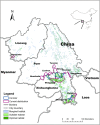Conflict between conservation and development: cash forest encroachment in Asian elephant distributions
- PMID: 28775252
- PMCID: PMC5543071
- DOI: 10.1038/s41598-017-06751-6
Conflict between conservation and development: cash forest encroachment in Asian elephant distributions
Abstract
Over the last 4 decades, China has undergone major economic development, resulting in considerable impacts on its wildlife populations and habitats. It is essential to quantify the conflict between development and conservation to assist with policy-making because forestry policies and market trends affected indirectly the distribution of Asian elephants. Here, we mapped the historical distribution of elephants versus human land use. Elephant distributions appear to occur in unbroken natural forests only. However, over the 40-year period, the distribution ranges have become smaller and fragmented, with natural forest area also declining by 16%. The monoculture of cash trees is encroaching on natural forests. Over the past 10 years, rubber plantations have become concentrated in the south, with extensive natural forests and scattered rubber farms being converted to tea plantations, due to changes in governmental policies and product prices. Through mapping the spatial changes in the distribution of rubber and tea plantations, our study is expected to help local managers to incorporate the needs of endangered elephants through creating space when planning plantations, especially in Xishuangbanna and the south part of Pu'er. In conclusion, restoring elephant habitat and establishing ecological corridors are critical for the survival of elephants in this region.
Conflict of interest statement
The authors declare that they have no competing interests.
Figures






References
-
- Sukumar R. A brief review of the status, distribution and biology of wild Asian elephants Elephas maximus. International Zoo Yearbook. 2006;40:1–8. doi: 10.1111/j.1748-1090.2006.00001.x. - DOI
-
- Shou, Z. H., Gao, Y. T. & Lu, C. K. The elephants in southern Yunnan. Chinese Journal of Zoology5, 204–109 (1959).
-
- Wu, J. L., Jiang, W. G., Hu, J. S., Li, Z. Q. & Li, C. H. Historical distribution changes of the Asian elephant in Xishuangbanna in the past 40 years. Chinese Wildlife3, 8–9 (1999).
-
- Sukumar R, Ramakrishnan U, Santosh JA. Impact of poaching on an Asian elephant population in Periyar, southern India: a model of demography and tusk harvest. Anim. Conserv. 1998;1:281–291. doi: 10.1111/j.1469-1795.1998.tb00039.x. - DOI
-
- Sukumar, R. The Asian Elephant: Ecology and Management. (Cambridge University Press, 1989).
Publication types
MeSH terms
LinkOut - more resources
Full Text Sources
Other Literature Sources
Miscellaneous

